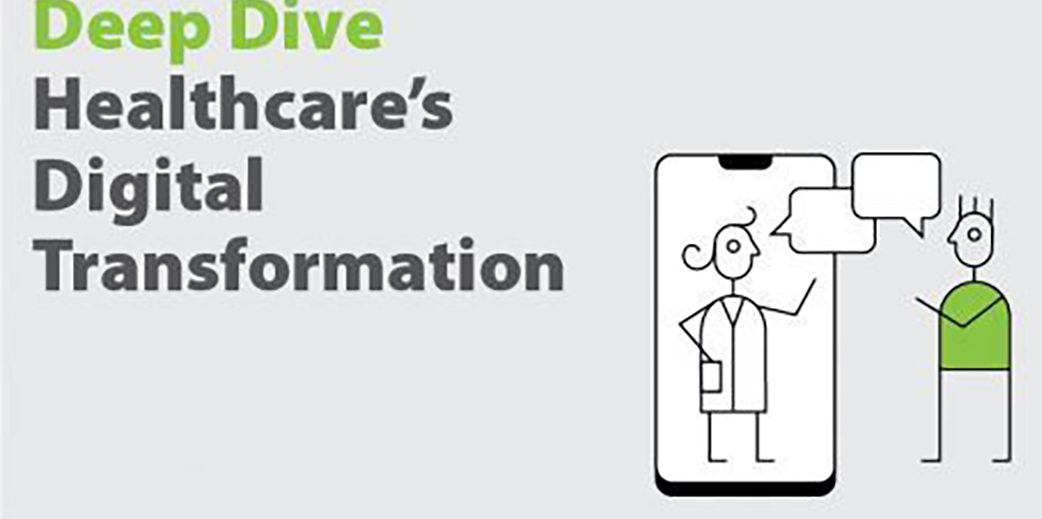Part 2 of our Deep Dive into healthcare’s digital transformation

The pandemic has accelerated the evolution of digital healthcare. We’re seeing a broader spectrum of care solutions applied, including virtual, digital, retail, and in-home. From back-office processes to patient-facing experiences, digital technology is driving rapid transformation. Yet despite a threefold increase in patients using virtual care, few are actually satisfied with the quality of that care.

Prefer to read this article as a PDF? Click here to download the full PDF version.
How can healthcare organizations create seamless experiences that build convenience, trust, and loyalty? ThoughtForm has joined with digital strategy firm SDLC Partners to conceptualize new ways to address digital healthcare. Weaving together strategy, technology, and culture, we’re reframing digital healthcare with design thinking as the catalyst.
Recently, our teams came together to discuss three challenges affecting health plans, provider organizations, pharma, and healthcare technology companies:
- Fielding blended healthcare models that integrate digital and traditional care delivery
- Optimizing healthcare processes through digitization and automation
- Creating a welcoming entry to digital channels for patients, providers, and employees
Over the next several weeks, we’ll examine each of these challenges in detail, and offer strategies you can use to meet them.
Trend #2:
Optimizing healthcare processes through digitization and automation
Gartner’s 2020 Hype Cycle for U.S. Healthcare Payers stresses that digitalization is an urgent survival imperative. According to Forbes, “…COVID-19 has put patients back in the middle of their care and forced organizations to streamline services and find innovative solutions.”
Many healthcare organizations were already on a digital transformation journey before COVID-19. But the pandemic has highlighted the need to prioritize streamlined services while preserving patients’, providers’, and employees’ quality of experiences. Tools like chatbots, robotic process automation (RPA), and algorithm-enabled diagnostics can free healthcare organizations to allocate resources to emerging needs.
These shifts, however, require significant procedural and experiential changes.
What’s our take on this trend?
Optimizing operational processes is about much more than cost savings. It’s about higher quality and greater consistency of services that yield better outcomes, and consumer and clinician experiences. A major benefit? Releasing capacity that fuels growth.
Uber-type disruptors like Iora Health in primary care and Oscar health insurance are raising the stakes. These first movers enjoy the advantage of a sleek digital model built from a clean slate with fewer legacy constraints.
As employers create more direct relationships with providers and payers, these new arrangements should be built on a digital-first approach. Organizations that integrate digital and automated processes while preserving the quality of experience for patients, providers, and employees will reap enormous rewards and market strength.

What’s our advice to healthcare organizations?
- Don’t wait for an Uber or Amazon to force your organization to change. If you aren’t already doing so, view the healthcare experience you deliver as being ripe for large-scale transformation.
- To counter the advantage of disruptors, leverage the deep wells of institutional wisdom that they lack. Involve on-the-ground teams closely in visioning, planning, and implementing new systems.
- Visibly connect internal initiatives to your “why” and to your growth, service, and operational plans. Ensure that every employee sees themselves in this picture.
- Organizations tend to approach cost reduction and growth as one goal. Those that explicitly allocate time to each can achieve more, faster.
- Don your systems thinking hat and pay attention to the interrelationships and interfaces among people, process, systems, and data. Leveraging small interventions can help you scale more easily.
- Understand where and when to automate fully, when to retain a human element or where to blend human workforce with robotic automation. Search for the simplest tools that will accomplish your purpose.
How should your post-pandemic digital transformation look
This merely scratches the surface of what’s currently happening in healthcare. We want to explore what trends could mean for your organization.
ThoughtForm and SDLC Partners have created a strategic partnership to help healthcare organizations quickly develop services, technologies, processes, and experiences that fit both their consumers and the enterprise.
Together, we offer a new approach to delivering innovation that addresses strategy, technology, and culture—all powered by design thinking.

